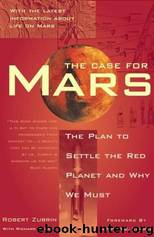The Case for Mars: The Plan to Settle the Red Planet and Why We Must by Robert Zubrin & Richard Wagner

Author:Robert Zubrin & Richard Wagner
Language: eng
Format: mobi
Tags: Non-Fiction, Science, Travel, Politics
ISBN: 9781451608113
Publisher: Touchstone
Published: 1996-01-01T05:00:00+00:00
* * *
FOCUS SECTION—A CALENDAR FOR THE PLANET MARS
Martian colonists will need a calendar that is tied to physical and seasonal conditions on the Red Planet—using Earth dates just won’t do. If I tell you it is February 1, you know that it is freezing in Minneapolis and high summer in Sydney, but what does it tell you about conditions on Mars? In fact, the need for a Martian calendar and timekeeping system is already upon us because of current and planned unmanned exploration missions. You know the season on Earth now and can predict it with ease for any date named in the future, but without a Martian calendar you’ll be hard pressed to do the same there. So we might as well remedy this right now.
Here is the problem: Mars has a year consisting of 669 Martian days, or “sols.” As we have seen, the correct method to measure time within these days is to use units 1.0275 times longer than their terrestrial counterparts. But equipartitioned months don’t work for Mars, because the planet’s orbit is elliptical, which causes its seasons to be of unequal length.
In order to predict the seasons, a calendar must divide the planet’s orbit not into equal division of days, but into equal angles of travel around the Sun. If we want months to be useful units and choose to retain the terrestrial definition of a month as a twelfth of a year, then a month really is 30 degrees of travel about the Sun. But what to name them? Using the current terrestrial month names could be confusing, and a totally new system would be completely arbitrary. There is, however, a set of names available that has long been universally known to humanity and that has real physical significance not only for Mars, but for any planet in our solar system—the signs of the zodiac. All the constellations of the zodiac lie in the plane of motion of all the planets. Ancient astrologers, having a geocentric point of view, named the months for whatever zodiacal constellation the Sun appeared to be located in as viewed from Earth. An interplanetary culture, though, must adopt a heliocentric—or Sun centered—point of view. Therefore, I have chosen to name the Martian months for whatever constellation Mars would be found in as seen from the Sun. For Martian colonists then, the sign of the month would be seen high in the sky during the midnight hours of a given month. It is currently the custom among planetary scientists to start a planet’s year with the vernal equinox (the beginning of spring, March 21, in the Earth’s northern hemisphere), and so, consistent with that custom, the Martian year begins with the month of Gemini and ends with Taurus. The complete Martian year is given in Table 6.3.
TABLE 6.3
The Mrtian Year
Download
This site does not store any files on its server. We only index and link to content provided by other sites. Please contact the content providers to delete copyright contents if any and email us, we'll remove relevant links or contents immediately.
| Aerodynamics | Aircraft Design & Construction |
| Astronautics & Space Flight | Avionics |
| Gas Dynamics | Propulsion Technology |
Whiskies Galore by Ian Buxton(41874)
Introduction to Aircraft Design (Cambridge Aerospace Series) by John P. Fielding(33064)
Small Unmanned Fixed-wing Aircraft Design by Andrew J. Keane Andras Sobester James P. Scanlan & András Sóbester & James P. Scanlan(32743)
Craft Beer for the Homebrewer by Michael Agnew(18140)
Turbulence by E. J. Noyes(7935)
The Complete Stick Figure Physics Tutorials by Allen Sarah(7307)
Kaplan MCAT General Chemistry Review by Kaplan(6866)
The Thirst by Nesbo Jo(6826)
Bad Blood by John Carreyrou(6546)
Modelling of Convective Heat and Mass Transfer in Rotating Flows by Igor V. Shevchuk(6391)
Learning SQL by Alan Beaulieu(6209)
Weapons of Math Destruction by Cathy O'Neil(6142)
Man-made Catastrophes and Risk Information Concealment by Dmitry Chernov & Didier Sornette(5921)
Digital Minimalism by Cal Newport;(5662)
Life 3.0: Being Human in the Age of Artificial Intelligence by Tegmark Max(5474)
iGen by Jean M. Twenge(5366)
Secrets of Antigravity Propulsion: Tesla, UFOs, and Classified Aerospace Technology by Ph.D. Paul A. Laviolette(5309)
Design of Trajectory Optimization Approach for Space Maneuver Vehicle Skip Entry Problems by Runqi Chai & Al Savvaris & Antonios Tsourdos & Senchun Chai(5011)
Pale Blue Dot by Carl Sagan(4909)
